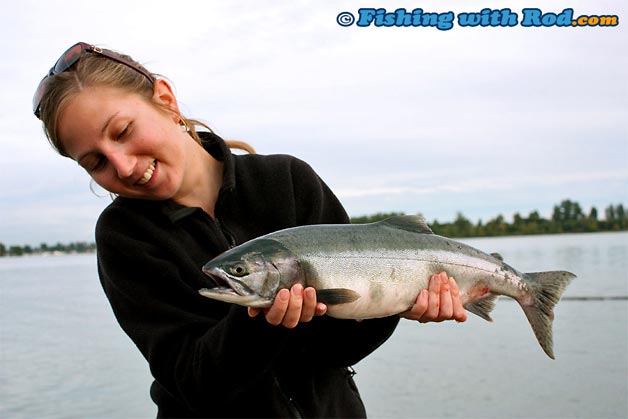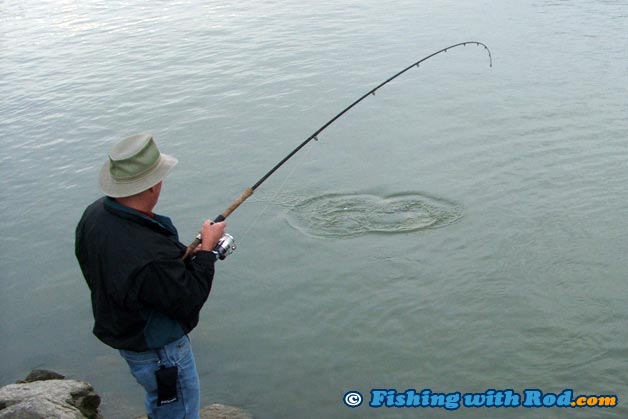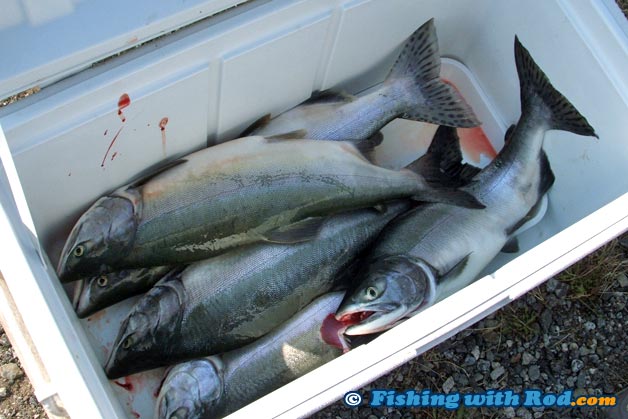Fishing for Tidal Fraser Pink Salmon
By Rodney Hsu, Fishing with Rod | Published in August 2007

Christmas arrives several months earlier every two years for anglers who regularly fish the Tidal Fraser River. September of each odd year marks the return of millions of pink salmon. This species is the smallest in the pacific salmon family due to its short lifespan. Its aggressiveness also makes it a fantastic gamefish for entry-level anglers. The most common method used to target pink salmon in the Tidal Fraser River is spincasting artificial lures. With a few tips on gear and timing, it is a fishery that every Lower Mainlanders can enjoy readily.
Rod, Reel & Terminal Tackle
Pink salmon spend less than two years in the ocean, therefore the average weight is between 4 and 6lb. Fish up to 10lb are not unheard of and can often be a surprising catch. A spinning rod rated between 4 and 10lb is adequate enough for this fishery. Its length is best at 8 feet, for optimal casting and better control when landing fish along the rocky shoreline. The rod tip should be sensitive, because pink salmon can be soft biters at times. A medium size spinning reel spooled with 8lb test monofilament line fits well with this rod.
Terminal tackle for pink salmon is simple; a selection of common salmon lures in a box is all you need to carry. Generally, most anglers believe pink is the best colour, but bright colours such as green, chartreuse, yellow, orange are just as effective. Although spinners and jigs are all productive, my favorite is a ¼oz spoon tied directly onto the main line. This set up is simplistic, which avoids problems when casting, retrieving and landing a fish.
Timing & Locations

Past data from test fisheries have shown that the bulk of the Fraser River pink salmon run arrives precisely in the last week of August or first week of September. Scattered schools often enter the river throughout August but they are hard to find and catch. In the Tidal Fraser River, best fishing usually takes place during the first two weeks of September, but the run can last until as late as early October.
The fishing is typically tidal dependent. Best time is often during an incoming tide that has a large tidal difference (8ft or more). Large schools of pink salmon use the strong current as an advantage to enter the river, so anglers should expect them several hours before flood tides.
Just like fishing for other migratory species, there are no best locations for pink salmon. In my opinion, timing is often more important than your choice of location. Most locations will produce. After all, the fish have to pass through every section of the river to reach the spawning ground. Your success can be achieved by frequently checking the river during the time when pink salmon are most likely to move through. Signs of pink salmon are usually the surfacing of their fins near close to shore.
Areas where the current is slower during strong tide are often very productive. They will also stop and circle in bays and tributary mouths. The key is to focus on areas where pink salmon will most likely take a break. Traveling fish are much harder to catch because the chance of your lure encountering the fish is much smaller if they are on the move.
Techniques

Frankly, spincasting is as simple as cast and retrieve. There are two components that you can vary to improve your catch – fishing depth and retrieving speed. The general misconception is that the lure has to be at a great depth in order to catch a salmon. This is not necessarily the case, especially for pink salmon. In fact, quite often I begin my retrieve as soon as the lure hit the water surface. Active fish will chase down a lure at all cost.
Your retrieving speed determines the lure speed as well as its action. A slow retrieve may produce a flutter action, while faster retrieve often causes the lure to spin. One should also take the tidal current into account when adjusting the retrieving speed. A strong current will push the lure to the surface, so it is important to slow down your retrieving speed under this scenario. Be sure to experiment! If one technique does not work for awhile when the fish are running, then change up or you may go home empty handed.
When retrieving your lure, keep your rod tip downward so it sits right above the water surface. This allows your lure to maintain its desired depth. It also provides sufficient amount of space for you to set the hook when the fish bites. From my own personal experience, I find that false bites sometimes take place prior to the commitment. As you retrieve the lure, quite often you would feel some light taps. This indicates that the fish are following and bumping into your hook as they chase the lure down. When this occurs, continue reeling in slowly. A distinct strike would often take place soon after.
Once you set the hook, pink salmon don't immediately run and peel the line off your reel like other salmon species. The fish often feels like a dead weight, followed by a few headshakes before the fight begins. Keep the line tight so the hook does not fall out during the headshakes.
A landing net is a must, preferably a soft mesh one in case you catch a species that is required to be released. The steep terrain at most locations in the Tidal Fraser River makes landing fish by hand rather difficult. A landing net improves your landing ratio and also assists you to release a fish properly when necessary.
Important Notes

Before heading out to your first Tidal Fraser River pink salmon trip, there are several important things that you need to know.
- You need a tidal sportfishing license and a salmon tag when fishing for salmon in the Tidal Fraser River.
- Be sure to check the daily quota of pink salmon, which may change based on the seasonal run size forecast.
- You must use a single barbless hook when fishing in the Tidal Fraser River. Most store-bought lures come with a treble hook or barbed hook. Be sure to switch the hook and pinch the bar down with a pair of plyers.
- Make sure you know how to identify all of the salmon species. During the time when pink salmon are entering the Fraser River, other salmon and trout species are also in the river.
- Some species are protected and cannot be kept, such as wild coho salmon, bull trout, cutthroat trout and steelhead. It is your responsibility to make sure these fish are safely released if caught.
- Please respect residents and wildlife around your fishing area by keeping the noise level down and picking up your own garbage.
- If you witness a fishery violation, please phone 604-607-4186 or 1-800-465-4336.
With some persistence and adaptation, you will be rewarded with some ocean fresh pink salmon!

